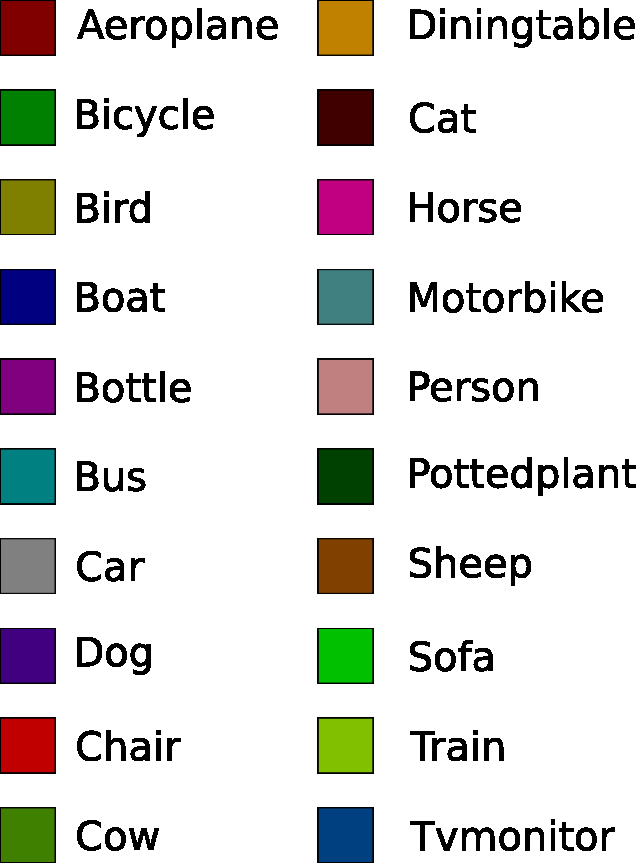Semantic segmentation of images with PixelLib using Pascalvoc model¶
PixelLib is implemented with Deeplabv3+ framework to perform semantic segmentation. Xception model trained on pascalvoc dataset is used for semantic segmentation.
Download the xception model from here.
Code to implement semantic segmentation:
import pixellib
from pixellib.semantic import semantic_segmentation
segment_image = semantic_segmentation()
segment_image.load_pascalvoc_model("deeplabv3_xception_tf_dim_ordering_tf_kernels.h5")
segment_image.segmentAsPascalvoc("path_to_image", output_image_name = "path_to_output_image")
We shall take a look into each line of code.
import pixellib
from pixellib.semantic import semantic_segmentation
#created an instance of semantic segmentation class
segment_image = semantic_segmentation()
The class for performing semantic segmentation is imported from pixellib and we created an instance of the class.
segment_image.load_pascalvoc_model("deeplabv3_xception_tf_dim_ordering_tf_kernels.h5")
We called the function to load the xception model trained on pascal voc.
segment_image.segmentAsPascalvoc("path_to_image", output_image_name = "path_to_output_image")
This is the line of code that performs segmentation on an image and the segmentation is done in the pascalvoc’s color format. This function takes in two parameters:
path_to_image: the path to the image to be segemented.
path_to_output_image: the path to save the output image. The image will be saved in your current working directory.
Sample1.jpg

import pixellib
from pixellib.semantic import semantic_segmentation
segment_image = semantic_segmentation()
segment_image.load_pascalvoc_model("deeplabv3_xception_tf_dim_ordering_tf_kernels.h5")
segment_image.segmentAsPascalvoc("sample1.jpg", output_image_name = "image_new.jpg")

Your saved image with all the objects present segmented.
You can obtain an image with segmentation overlay on the objects with a modified code below.
segment_image.segmentAsPascalvoc("sample1.jpg", output_image_name = "image_new.jpg", overlay = True)
We added an extra parameter overlay and set it to true, we produced an image with segmentation overlay.

Specialised uses of PixelLib may require you to return the array of the segmentation’s output.
- Obtain the array of the segmentation’s output by using this code,
segvalues, output = segment_image.segmentAsPascalvoc()
- You can test the code for obtaining arrays and print out the shape of the output by modifying the semantic segmentation code below.
import pixellib
from pixellib.semantic import semantic_segmentation
import cv2
segment_image = semantic_segmentation()
segment_image.load_pascalvoc_model("deeplabv3_xception_tf_dim_ordering_tf_kernels.h5")
segvalues, output = segment_image.segmentAsPascalvoc("sample1.jpg")
cv2.imwrite("img.jpg", output)
print(output.shape)
Note: Access the masks of the objects segmented using segvalues[“masks”] and their class ids using segvalues[“class_ids”].
- Obtain both the output and the segmentation overlay’s arrays by using this code,
segvalues, segoverlay = segment_image.segmentAsPascalvoc(overlay = True)
import pixellib
from pixellib.semantic import semantic_segmentation
import cv2
segment_image = semantic_segmentation()
segment_image.load_pascalvoc_model("deeplabv3_xception_tf_dim_ordering_tf_kernels.h5")
segvalues, segoverlay = segment_image.segmentAsPascalvoc("sample1.jpg", overlay= True)
cv2.imwrite("img.jpg", segoverlay)
print(segoverlay.shape)
This xception model is trained on pascal voc dataset, a dataset with 20 object categories.
Objects and their corresponding colormaps.

Process opencv’s frames
import pixellib
from pixellib.semantic import semantic_segmentation
import cv2
segment_frame = semantic_segmentation()
segment_frame.load_pascalvoc_model("deeplabv3_xception_tf_dim_ordering_tf_kernels.h5")
capture = cv2.VideoCapture(0)
while True:
ret, frame = capture.read()
segment_video.segmentFrameAsPascalvoc(frame, output_image_name= "hi.jpg")